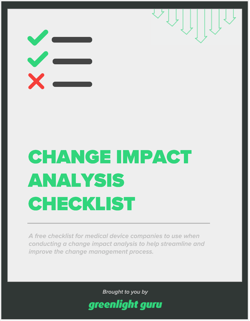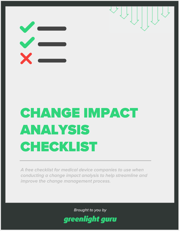5 Strategies to Limit Project Timeline and Cost for your Medical Device

Creating success in the medical device industry is about sustainable growth and repeatable processes. But all of that is really a longer way of saying “change management.”
Changes during the medical device design process can occur for a number of reasons and be enacted by a variety of stakeholders and forces, both intentional and not. These include:
-
Product requirements
-
Design requirements
-
Technology implementation
-
Competitor products
-
Regulatory requirements
-
Supply chain delays
With delays to product marketability and high upfront budget costs, you need to ensure your team is working smarter, harder, and cohesively. Here are five strategies for reducing your time to market and medical device expenses.
FREE DOWNLOAD: Click here to download your free PDF copy of our checklist for conducting your change impact analysis.
1. Move Your Design Changes Upstream
If change is the only constant in the medical device world, then finding sustainable success depends largely on your ability to anticipate those changes and mitigate their negative impacts on timeline and budget. This is synonymous with the Fail Fast mindset, which encourages an iterative, hypothesis-driven approach to product development.
One potential area of underutilized opportunity for medical device firms can be found in the prototyping stages of device design. Prototypes are an invaluable tool throughout every phase of product development, particularly for appearance and proof-of-concept models which typically occur before the formal implementation of design controls.
In order to maximize the benefits of prototyping, consider shifting more “controversial” design features like those related to performance and behavior into early prototypes in order to gain feedback and insight.
It’s equally important to still be capturing and considering design controls during the prototype stages. This ensures user needs are kept top of mind. When done correctly, not only does the prototyping approach put shape around the device (both literally and figuratively), prototypes also can save significant time by creating a more efficient workflow.
2. Front Load Systemic Change
Both medical devices and software development have buzzwords abound. Though some of them are forgettable or even regrettable, the ones that stick around do so because they’re true. As a result, I can’t help but embrace the ones that speak to the virtues of change management, particularly the Shift Left approach.
Though it was initially rooted in software testing, shifting left is now being applied to other areas of the development process, such as security and deployment. The idea is to take a task that's traditionally done at a later stage of the process and perform it at earlier stages.
Enabling your team to adopt the “shift left” approach to development requires prioritization. What processes would benefit most from being moved upstream? Where are you seeing bottlenecks, particularly in later-stage development activities?
In general, we should be focusing on three front loading changes that require more seismic movements, specifically:
-
Usability
-
Cybersecurity
-
Safety (behavior related)
Notice that we’re not just moving the order of things or skipping testing altogether. Instead, we are taking time-consuming and costly activities and spreading them evenly across a workflow. Not only does this lead to less time spent fixing mistakes, it also allows your team to be better utilized.
3. Aim for the MVP (Minimum Viable product)
Another common design philosophy born out of the startup world is MVP, or minimum viable product. At its core, MVPs are the most basic iteration of a product that still offers enough real value to consumers to gain traction in the market.
This can mean dramatically different things depending on the device, especially between risk classes and intended use; however, the intent of an MVP approach is the same: safer devices getting to patients faster.
So, what are the basic requirements of an MVP in medical devices? You’ll be looking to minimally cover the requirements of the intended use and indications for use of the device. This is why it’s so important to develop succinct definitions for both statements early on.
MVPs can have retroactive, positive impacts in post-submission and post-market stages well after a final device has been approved. This is due to the ability to roadmap and prioritize non-MVP features, i.e non-critical features. When these evolutionary changes come up in a product life cycle, non-critical features may best be reserved for a letter-to-file.
Keep in mind that producing an MVP should be about reducing complexity, not lowering your standards in a race to the finish.
4. Accelerate schedules from the start
A major factor in your time to market is how you define schedules and timelines during product development. Accelerating these schedules as an early expectation is the only reasonable way to handle time management, especially if you’re looking to make systemic changes to how your team works. When done correctly, it empowers employees to trust themselves and the process.
A common example of accelerating timelines from the start is with the Artificial Deadline concept. An artificial deadline is one imposed by management rather than one based on customer expectations or legal requirements. While this can be effective initially, over time employees may lose trust in management’s honesty.
While there are countless resources out there to help with improving your team’s time management, if you’re looking to revamp this process it’s a good idea to work with a specialist.
FREE DOWNLOAD: Click here to download your free PDF copy of our checklist for conducting your change impact analysis.
5. Leverage a QMS that supports development
Working out of a QMS is a pretty basic requirement for medical device manufacturers. But, when we view the QMS as a checkbox activity, it not only sets us up for mediocre products, it also diminishes the massive value that it can provide. When paired with the right eQMS solution, design teams can use deliberate timing of design controls to streamline your processes.
Greenlight Guru is the only eQMS solution designed by medical device professionals specifically for medical devices. Our cloud-based platform allows companies to bring safer products to market faster, while reducing risk, and lowering costs, all in an effort to shift the focus from compliance to True Quality.
If you’re ready to learn more contact us today for your free, personalized demo of Greenlight Guru!
Looking for a design control solution to help you bring safer medical devices to market faster with less risk? Click here to take a quick tour of Greenlight Guru's Medical Device QMS software
Etienne Nichols is the Head of Industry Insights & Education at Greenlight Guru. As a Mechanical Engineer and Medical Device Guru, he specializes in simplifying complex ideas, teaching system integration, and connecting industry leaders. While hosting the Global Medical Device Podcast, Etienne has led over 200...
Related Posts
Top 50 Medical Device Product Design and Development Companies
Interviewing the Interviewer
Managing Major Changes to Medical Device Packaging
Get your free resource
Change Impact Analysis Checklist











